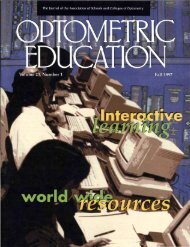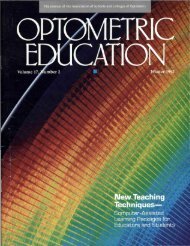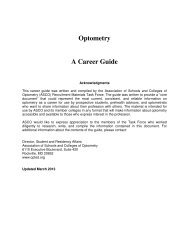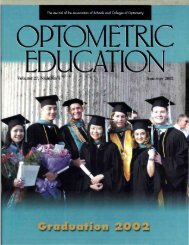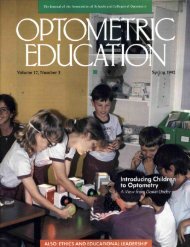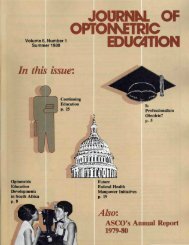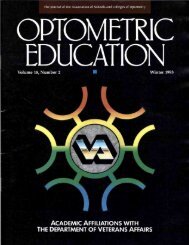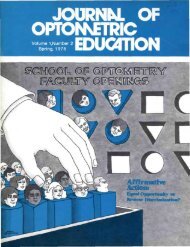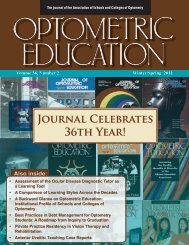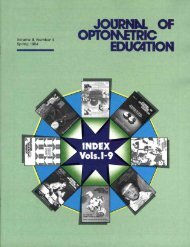JOURNN. OF - Association of Schools and Colleges of Optometry
JOURNN. OF - Association of Schools and Colleges of Optometry
JOURNN. OF - Association of Schools and Colleges of Optometry
Create successful ePaper yourself
Turn your PDF publications into a flip-book with our unique Google optimized e-Paper software.
that <strong>of</strong> percent <strong>of</strong> time devoted to various<br />
activities as a function <strong>of</strong> academic<br />
rank. Table 6 compares various studies<br />
with this question in mind. Considering<br />
these sources there seems to be some<br />
tendency for teaching activity to decrease<br />
<strong>and</strong> public service activity to increase<br />
the higher the rank. Research<br />
activities <strong>and</strong> "other" activities remain<br />
about the same irrespective <strong>of</strong> rank as a<br />
general statement.<br />
There is not a general agreement on<br />
such a generalization, however. Jackameit<br />
40 at Madison College found pr<strong>of</strong>essors<br />
<strong>and</strong> associate pr<strong>of</strong>essors devoted a<br />
larger percentage <strong>of</strong> time to research<br />
<strong>and</strong> scholarly activities than was evidenced<br />
by the college as a whole. However,<br />
Hesseldenz <strong>and</strong> Rodgers 41 in a<br />
comprehensive statistical study <strong>of</strong> 2,406<br />
classes taught at the University <strong>of</strong> Kentucky<br />
concluded:<br />
(a) Average credit hours for classes<br />
taught by assistant pr<strong>of</strong>essors are significantly<br />
higher than for classes<br />
taught by each other rank; (b) contact<br />
hours for classes taught by pr<strong>of</strong>essors<br />
are lower than those for<br />
classes taught by each other rank; (c)<br />
associate pr<strong>of</strong>essors average less effort<br />
in preparation-grading hours<br />
than do instructors <strong>and</strong> the average<br />
<strong>of</strong> all other ranks. Instructors spend<br />
significantly more time in this effort<br />
than do all other ranks; <strong>and</strong> (d) pr<strong>of</strong>essors<br />
spend less time in average<br />
class total hours than do assistant<br />
pr<strong>of</strong>essors <strong>and</strong> instructors. Associate<br />
pr<strong>of</strong>essors exhibited smaller values<br />
than assistant pr<strong>of</strong>essors for this variable.<br />
Instructors had higher values<br />
for this variable than any other rank.<br />
Level <strong>of</strong> Instruction<br />
Differentiation <strong>of</strong> instructional workload<br />
according to level <strong>of</strong> instruction is<br />
presented in a position paper by the<br />
American <strong>Association</strong> <strong>of</strong> University Pr<strong>of</strong>essors<br />
(AAUP). 36 The AAUP proposes<br />
a teaching workload <strong>of</strong> 9-12 credit<br />
hours for teachers <strong>of</strong> predominantly undergraduate<br />
courses <strong>and</strong> 6-9 credit<br />
hours for instruction at the graduate<br />
level. At most institutions <strong>of</strong> higher<br />
learning, the higher the rank <strong>of</strong> the<br />
faculty member the higher the level <strong>of</strong><br />
classes taught. If the AAUP guideline is<br />
followed, one effect is the releasing <strong>of</strong><br />
proportionately greater amounts <strong>of</strong> time<br />
to senior faculty members. The release<br />
<strong>of</strong> time for what, however, is not clear.<br />
Since higher-ranked faculty members<br />
teach more <strong>of</strong> the higher level courses,<br />
<strong>and</strong> some propose that higher level<br />
courses take greater time in preparation,<br />
the inference is that higher-ranked<br />
faculty members spend more total time<br />
on the courses they teach. But do they?<br />
This question among others was researched<br />
at the University <strong>of</strong><br />
Kentucky. 41 In the comparison <strong>of</strong> level<br />
<strong>of</strong> instruction with class total hours,<br />
there was neither a significant relationship<br />
overall nor by rank at the .01 level.<br />
Virtually no relationship was found to<br />
exist between the level <strong>of</strong> instruction <strong>of</strong><br />
a class <strong>and</strong> the total amount <strong>of</strong> time<br />
spent on the class; as much time was<br />
spent on a lower-division class as was<br />
spent on a graduate class or as little.<br />
This conclusion is reinforced by studies<br />
at the University <strong>of</strong> Maryl<strong>and</strong>. 42 They<br />
found that the production <strong>of</strong> student<br />
credit hours per full-time equivalent<br />
faculty member varied greatly by segment,<br />
by level <strong>of</strong> instruction, <strong>and</strong> by<br />
field <strong>of</strong> knowledge, but the analysis <strong>of</strong><br />
course load information by course level<br />
revealed nearly constant amounts <strong>of</strong><br />
TABLE 6<br />
Percent <strong>of</strong> Time Per Week <strong>of</strong> Full-Time Faculty by Activity by Academic Rank<br />
Activity<br />
X<br />
On-1<br />
Univ. <strong>of</strong><br />
Maryl<strong>and</strong>"<br />
Madison<br />
College 40<br />
Humboldt St.<br />
College 50<br />
State<br />
<strong>Colleges</strong> 42<br />
Private<br />
<strong>Colleges</strong>"<br />
Community<br />
<strong>Colleges</strong> 42<br />
Teaching<br />
PR<strong>OF</strong><br />
ASOP<br />
ASIP<br />
INSR<br />
LECR<br />
Mean<br />
55.5<br />
61.1<br />
64.6<br />
62.6<br />
—<br />
60.9<br />
6.7<br />
5.5<br />
6.1<br />
5.1<br />
-<br />
43.8<br />
50.3<br />
53.2<br />
59.8<br />
*<br />
54.9<br />
62.8<br />
70.2<br />
55.8<br />
62.3<br />
61.9<br />
64.4<br />
64.1<br />
62.3<br />
73.1<br />
57.9<br />
63.5<br />
64.3<br />
66.0<br />
*<br />
52.9<br />
60.8<br />
68.2<br />
61.3<br />
*<br />
61.4<br />
65.1<br />
67.6<br />
70.6<br />
—<br />
Research<br />
PR<strong>OF</strong><br />
ASOP<br />
ASIP<br />
INSR<br />
LECR<br />
Mean<br />
17.6<br />
17.1<br />
16.4<br />
15.9<br />
—<br />
16.75<br />
7.6<br />
8.2<br />
6.7<br />
7.0<br />
-<br />
30.2<br />
29.7<br />
28.0<br />
24.7<br />
*<br />
15.2<br />
15.6<br />
13.0<br />
10.4<br />
11.1<br />
7.3<br />
6.1<br />
7.8<br />
6.3<br />
16.1<br />
15.5<br />
13.5<br />
17.8<br />
16.6<br />
*<br />
21.4<br />
22.9<br />
16.8<br />
22.7<br />
*<br />
15.9<br />
14.8<br />
14.9<br />
14.7<br />
*<br />
Public Service<br />
PR<strong>OF</strong><br />
ASOP<br />
ASIP<br />
INSR<br />
LECR<br />
Mean<br />
21.8<br />
16.7<br />
14.3<br />
15.2<br />
-<br />
17.0<br />
3.7<br />
4.9<br />
4.4<br />
5.7<br />
-<br />
19.2<br />
13.3<br />
12.8<br />
10.2<br />
*<br />
27.8<br />
20.1<br />
12.9<br />
18.1<br />
25.5<br />
25.0<br />
23.9<br />
22.9<br />
25.5<br />
9.1<br />
20.4<br />
17.8<br />
13.7<br />
13.4<br />
*<br />
19.9<br />
10.0<br />
10.1<br />
13.2<br />
*<br />
18.6<br />
15.4<br />
13.5<br />
10.8<br />
*<br />
Other<br />
PR<strong>OF</strong><br />
ASOP<br />
ASIP<br />
INSR<br />
LECR<br />
Mean<br />
5.1<br />
4.9<br />
4.7<br />
6.3<br />
—<br />
5.25<br />
1.7<br />
1.8<br />
0.8<br />
4.7<br />
—<br />
6.8<br />
6.7<br />
6.0<br />
5.3<br />
*<br />
2.1<br />
1.5<br />
3.9<br />
15.7<br />
1.1<br />
5.7<br />
5.5<br />
5.2<br />
5.9<br />
1.6<br />
6.2<br />
5.2<br />
4.2<br />
4.0<br />
*<br />
5.8<br />
6.3<br />
4.9<br />
2.8<br />
*<br />
4.1<br />
4.7<br />
4.0<br />
3.9<br />
*<br />
'Data not available.<br />
16 Journal <strong>of</strong> Optometric Education



